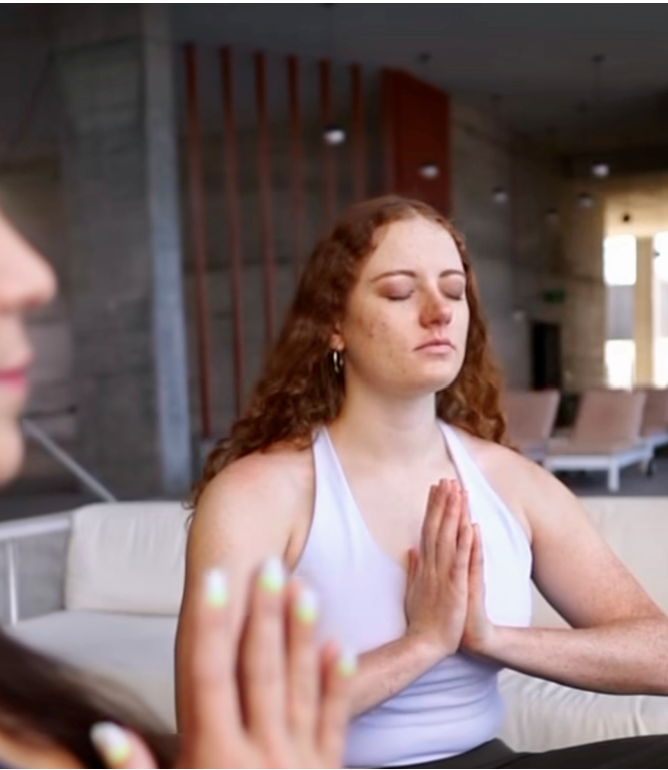Picture this: the sun’s early morning rays shining through the windows, bathing wooden floors in a golden glow. Dust dancing in the air around you, as you sit perched on a mat, legs crossed, hands in lap, and simply breathe.
It sounds blissful, doesn’t it? And yet, to just breathe is not as simple as I once thought it to be. Sure, it’s an instinct. Quite literally our first action when we enter this world is to take a deep, shaky breath, ushering air into our lungs while simultaneously altering our body’s anatomy, and then let it all out in a huge cry that announces our arrival. We’re taught that to breathe is not an action we must actively think about; our autonomic nervous system takes over a majority of the time, putting our lungs on autopilot, if you will, as we go about doing our daily tasks, our minds running a mile a minute, pondering, processing, and planning entirely too many things into too few hours while we still try to carve out time to eat and hydrate and move our bodies and sleep. Hardly are we ever given a moment to just be.
And then there are the moments where I want to take control of my breath, but I just can’t. One single mundane action or word sets off my fight or flight response, and my brain tells my lungs to expand and collapse faster and faster and faster. More oxygen, more, more! We are in danger, and we need to run far from it. Anxiety and panic, companions I never asked for but which insist on staying by my side, overriding my own thoughts, and commanding my lungs to take quick shallow breaths and my heart to flutter in my chest as though it’s sprouted wings.
The first two years in medical school have shoved so much information into my brain, more than I ever imagined was possible to contain within the confines of my skull, and yet, I would argue that perhaps the most important thing I learned how to do was breathe, and in this practice of breathing, I learned how to just be.
Breathwork and meditation are practices that I first approached with hesitancy. My preconceived notions had me thinking it was some woo-woo activity with the intent of leading you down some spiritual journey towards a higher power. And perhaps for some, it is that. I’m not here to judge. For me, it is a space where I can just sit, and focus solely on my breath, and let all my other worries, commitments, and responsibilities drift away to be called upon later as I dive deeper and deeper into my own body, opening channels along the way for my own energy to flow. If I’m able to dive deep enough, I find that I’m transported out of the studio I’m sitting in, consumed in a euphoric state of stillness, peace, and a warm glow of light that is the energy of my own making. A healing energy that I can give back to the world.
To get to this beautiful place, one must practice mindful breathing that teaches you to be comfortable with the uncomfortable. Physiologically, I know that the combination of various breathing exercises I may be guided through on any given day are designed to push me to hyperventilate, which in turn manifests into a tingling sensation that starts at the lips, fingers, and toes. Honestly, when I first started doing breathwork and meditation, that’s all I could think about; rationalizing the process with my newly gained medical knowledge of why my body was reacting in a certain way. But I’ve learned over time that if I just let go and be, eventually, my whole body will feel as though it’s ever so slightly vibrating, as if the energy within is stretching against skin and muscle and bone, pushing the atoms of my being apart. Fixating on that vibrating sensation, I find maybe I don’t need fresh air for a bit. I can just sit there in stillness, letting the air I’ve inhaled swirl within me, and be at ease with it. Comfortable with the uncomfortable.
It is in this space that I believe we can find our true selves and promote healing from within. As medical providers, it is crucial that we first take care of ourselves so we can provide the best care for our patients. “If one can learn to pay attention to oneself, one can really pay attention to one’s patients” [1]. If you take anything away from this, I encourage that it be to take a moment to be still, let the mind empty of everything, and breathe.
References
Kathleen LeFiles is a medical student from the Class of 2026 at The University of Arizona College of Medicine - Phoenix. She graduated in 2020 from The University of Arizona in Tucson with a degree in Physiology and a minor in Care, Health, and Society. When she's not studying or writing, Kathleen enjoys practicing Pilates and yoga, frequenting local coffee shops, and listening to pop music. Feel free to contact her @kathleenlefiles on Instagram or email at klefiles@arizona.edu.


